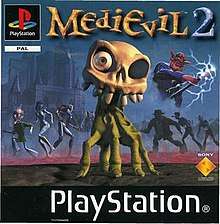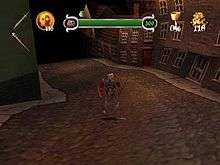MediEvil 2
| MediEvil 2 | |
|---|---|
 European cover art | |
| Developer(s) | SCE Cambridge Studio |
| Publisher(s) | Sony Computer Entertainment |
| Director(s) | James Shepherd |
| Producer(s) | Andrew Kennedy |
| Artist(s) | Jason Wilson |
| Writer(s) |
James Shepherd Jim Sangster |
| Composer(s) |
Andrew Barnabas Paul Arnold |
| Series | MediEvil |
| Platform(s) | PlayStation |
| Release | |
| Genre(s) | Action-adventure, hack and slash |
| Mode(s) | Single-player |
MediEvil 2, stylised as MediEvil II in North America, is an action-adventure hack and slash video game developed by SCE Cambridge Studio and published by Sony Computer Entertainment for the PlayStation. It is the second instalment of the MediEvil series and a sequel to MediEvil. It was first released on 19 April 2000 in Europe and 30 April 2000 in North America. Taking place 500 years after the events of the first game, it follows series' protagonist Sir Daniel Fortesque's revival in Victorian era London as he attempts to stop sorcerer Lord Palethorn and Jack the Ripper's plans to terrorise the city by raising the dead.
Following the positive reception of the first game, Sony Computer Entertainment commissioned SCE Cambridge Studio to make a sequel to MediEvil before the end of the PlayStation's lifespan. The original concepts for MediEvil 2 went through many transformations during development before the Cambridge team finally settled on making a sequel set during the Victorian Gothic revival, largely reminiscent of its predecessor. The game received mostly positive reviews from critics upon release, with praise including slight improvements over its predecessor, such as artificial intelligence and graphical enhancements, but was criticised for lack of innovation from the original.
Gameplay

The interface and gameplay style do not differ much from the previous title. MediEvil 2 sees the player once again in control of Sir Daniel Fortesque, who can use various forms of weaponry, such as close range swords and clubs to long-range crossbows and catapults.[1][2] MediEvil 2 contains several elements of gameplay, weaponry, and graphics that were present in the first instalment of the series. Similar to its predecessor, Dan is able to tear off his skeletal arm and use it as a club to fight off enemies during the early levels. Whilst featuring many classic swords and other medieval weaponry, new weapons featured in MediEvil 2 include the pistol, blunderbuss, and Gatling gun.[1][3]
Similar to the previous game, Dan's health is determined by a single health bar, which reduces when Dan is hit. If he drowns or falls from a great height, it depletes completely. Dan can extend his maximum health by collecting Life Bottles, which refill his health if the bar reaches zero. If Dan's health bar and Life Bottles are all completely empty, the game is lost and must be restarted from the last save point.
Dan can visit merchants known as 'Spivs' to purchase additional ammunition and services.[2] Dan may also receive advice from his ghost sidekick Winston to learn new moves or save the player's game between longer levels. In each level (except the last) there is a Chalice of Souls which fills up as Dan defeats enemies. When it reaches 100% Dan can collect and trade the chalice with Professor Kift to unlock a new weapon or item.[2]
Plot
The game begins 500 years after Sir Daniel Fortesque's battle against the evil sorcerer Zarok in events from the previous game. In Kensington, in the year 1886, a sorcerer named Lord Palethorn discovers Zarok's spellbook and casts its spell of raising the dead over the city of London. However, the pages of the book soon scatter across London and Palethorn gains a demon-like appearance as a result. The spell Palethorn casts once again brings Sir Daniel Fortesque, who was resting at a nearby museum, back to life. He is recruited by a professor named Hamilton Kift and his ghostly sidekick Winston Chapelmount (a play on Winston Churchill) to recover the pages of Zarok's spellbook and put a stop to Palethorn's plans. Along the way, they end up being joined by an ancient mummy princess named Kiya, Dan's future love interest.
During an incident in which Kiya goes off on her own, she is killed by Jack the Ripper, much to Dan's shock. Having discovered a time machine, Dan travels back in time to save Kiya in Whitechapel, merging with his past self to gain golden armour. As Dan finally confronts Palethorn, he steals the pages from him and uses them to summon a large blue demon. Dan manages to turn the demon against Palethorn, putting a stop to both of them. As Palethorn blows up his lair with his last breath, Dan decides to join Kiya in the afterlife as they return to their eternal rest. If the player has collected all the Chalices, Dan and Kiya go for a ride on the time machine which takes them back to the time of the first MediEvil instead.
Development
After the success of the first MediEvil, Sony Computer Entertainment commissioned SCE Cambridge to develop a sequel that would be released before the end of the PlayStation's lifespan. Chris Sorrell, who previously served as director of the first game, was not involved in development,[4] so the project was handed over to James Shepherd instead.[5][6] According to Shepherd, the original plot for MediEvil 2 had previous antagonist Zarok being held prisoner in the Tower of London and Sir Daniel Fortesque's objective would be to free him, but this idea was eventually dropped due it being considered identical to a "B-movie twist ending."[6]
The Cambridge studio believed it would not be difficult to make a sequel to the first MediEvil, considering that the ending of its predecessor would give the team an opportunity to set the next game in a different time period. Shepherd settled on MediEvil 2 being set in the Victorian era, the birthplace of the Neo-Gothic revival.[6] Shepherd considered the hardest part of the development was deciding how to make the game better than its predecessor by incorporating humorous elements in the game. To achieve this, the Cambridge studio re-coded a majority of its core technology, which Shepherd considered arguably similar to "starting from scratch."[6] Various features cut from the previous game were added into MediEvil 2, such as playable characters and levels that featured puzzles.[5] By the time the game reached beta status the game offered larger levels, improved NPC logic, and additional moves for the protagonist.[6]
Reception
| Reception | ||||||||||||||||
|---|---|---|---|---|---|---|---|---|---|---|---|---|---|---|---|---|
| ||||||||||||||||
MediEvil 2 received mostly positive reviews from critics upon release. The game was mostly praised for its rich detailed graphics but was criticised by many reviewers for its bad camera angles, easy difficulty, and similarity to the first game. The game received an aggregate score of 79% from GameRankings, slightly lower than its predecessor.[7] At the 2000 BAFTA Interactive Entertainment Awards, MediEvil 2 won the best console game category.[10]
IGN's Doug Perry praised the graphical advancements of the game, noting that the sharper details drew out a more "sophisticated feel" to the story. Perry noted that the new addition of cutscenes created a better sense of continuity and story, reconstructing the game into a more controlled, broader world.[1] Shawn Sparks of Game Revolution similarly praised the improved graphics, noting that smooth frame rates and sharper graphics brought out the original PlayStation's power, despite nearing the end of its lifespan. Sparks hailed the graphics as "eye candy" and reported that the levels were "a joy to explore."[9]
Perry noted the game's "plain wide confusion" in level layouts would cause frustration for players, and was several times found without direction in the larger levels.[1] Sparks also described similar concerns with the confusing level layout.[9] Perry disliked the fixed camera positioning throughout the game and outlined that the camera was "good, not great" and only a small improvement to its predecessor.[1] Daily Radar's Stephen Frost praised the game's improved artificial intelligence and harder difficulty in comparison to the first game, summarising that MediEvil 2 was "better, not perfect," although thought that the game was still lacking in innovation.[3]
References
- 1 2 3 4 5 6 Perry, Doug. "MediEvil II review - IGN". IGN. Retrieved 28 April 2015.
- 1 2 3 "MediEvil 2 gameplay". GameTrailers. Retrieved 28 April 2015.
- 1 2 Stephen, Frost. "DailyRadar review". DailyRadar. Archived from the original on 15 December 2000. Retrieved 28 April 2015.
- ↑ MediEvil 2 Manual. SCE Cambridge. 1995. p. 28.
- 1 2 "MediEvil developers Q&A". MediEvil Boards. ProBoards. Retrieved 20 April 2015.
- 1 2 3 4 5 Strohm, Axel (15 December 1999). "MediEvil 2 Director Interviewed". GameSpot. Retrieved 26 April 2015.
- 1 2 "MediEvil II aggregate score". GameRankings. Retrieved 28 April 2015.
- ↑ Marriott, Scott Alan. "MediEvil II". Allgame. Archived from the original on 10 December 2014. Retrieved 30 April 2015.
- 1 2 3 Sparks, Shawn. "MediEvil II review". GameRevolution. Retrieved 28 April 2015.
- ↑ "Interactive - Games - Console in 2000". bafta.org. British Academy of Film and Television Arts. Archived from the original on 2 April 2015. Retrieved 26 September 2015.